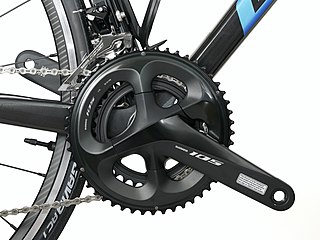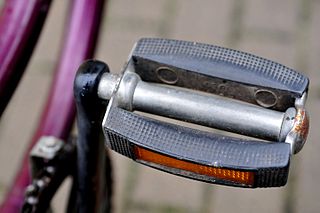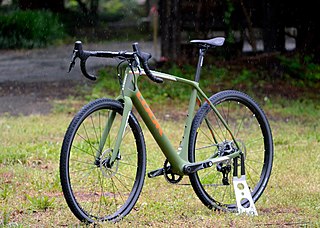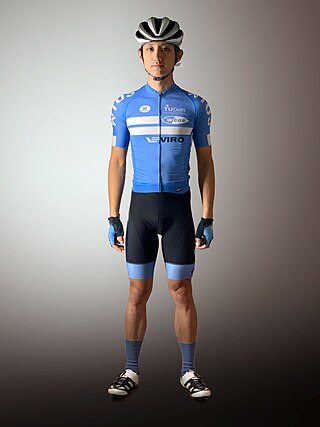
A shoe is an item of footwear intended to protect and comfort the human foot. Though the human foot can adapt to varied terrains and climate conditions, it is vulnerable, and shoes provide protection. Form was originally tied to function, but over time, shoes also became fashion items. Some shoes are worn as safety equipment, such as steel-toe boots, which are required footwear at industrial worksites.

A derailleur is a variable-ratio bicycle gearing system consisting of a chain, multiple sprockets of different sizes, and a mechanism to move the chain from one sprocket to another.
Shimano, Inc., originally Shimano Iron Works (島野鐵工所) and later Shimano Industries, Inc. (島野工業株式会社), is a Japanese multinational manufacturing company for cycling components, fishing tackle and rowing equipment, who also produced golf supplies until 2005 and snowboarding gear until 2008. Named after founder Shozaburo Shimano and headquartered in Sakai, Osaka Prefecture, the company has 32 consolidated and 11 unconsolidated subsidiaries, with the primary manufacturing plants based in Kunshan (China), Malaysia and Singapore.

The crankset or chainset is the component of a bicycle drivetrain that converts the reciprocating motion of the rider's legs into rotational motion used to drive the chain or belt, which in turn drives the rear wheel. It consists of one or more sprockets, also called chainrings or chainwheels attached to the cranks, arms, or crankarms to which the pedals attach. It is connected to the rider by the pedals, to the bicycle frame by the bottom bracket, and to the rear sprocket, cassette or freewheel via the chain.

The pedal is the part of a bicycle that the rider pushes with their foot to propel the vehicle. It provides the connection between the cyclist's foot or shoe and the crank allowing the leg to turn the bottom bracket spindle and propel the bicycle's wheels. A pedal usually consists of a spindle that threads into the end of the crank, and a body on which the foot rest is attached, that is free to rotate on bearings with respect to the spindle.

Clogs are a type of footwear made in part or completely from wood. Used in many parts of the world, their forms can vary by culture, but often remained unchanged for centuries within a culture.
Indoor cycling, often called spinning, is a form of exercise with classes focusing on endurance, strength, intervals, high intensity and recovery, and involves using a special stationary exercise bicycle with a weighted flywheel in a classroom setting. When people took cycling indoors in the late 19th century, whether for reasons of weather or convenience, technology created faster, more compact and efficient machines over time. The first iterations of the stationary bike ranged from the vertical Gymnasticon to regular bicycles on rollers.

A racing bicycle, also known as a road bike is a bicycle designed for competitive road cycling, a sport governed by and according to the rules of the Union Cycliste Internationale (UCI).
Due to the nature of triathlons as a race consisting of multiple sports many pieces of technical equipment have been borrowed from other sports, or developed specifically in an effort to race faster and improve a competitors safety.

Galoshes, also known by many other names, are a type of overshoe or rubber boot that is put on over shoes to keep them from getting muddy or wet during inclement weather.

Sports equipment, sporting equipment, also called as sporting goods, are the tools, materials, apparel, and gear used to compete in a sport and varies depending on the sport. The equipment ranges from balls, nets, and protective gear like helmets. Sporting equipment can be used as protective gear or a tool used to help the athletes play the sport. Over time, sporting equipment has evolved because sports have started to require more protective gear to prevent injuries. Sporting equipment may be found in any department store or specific sporting equipment shops.

Shimano Pedaling Dynamics, commonly called SPD, is a design of clipless bicycle pedals and associated cleats first released by Shimano in 1990. The first model, PD-M737, was aimed at mountain biking enthusiasts who, prior to this, had to use toe clips and straps or "road" clipless pedals which clogged with mud and made walking very difficult in unrideable situations.

A Goodyear welt is a strip of leather, rubber, or plastic that runs along the perimeter of a shoe outsole. The basic principle behind the Goodyear welt machine was invented in 1862 by August Destouy who designed a machine with a curved needle to stitch turned shoes. The machine was then improved in 1869 and later by Destouy and, more importantly, Daniel Mills, an English mechanic, both employed by Charles Goodyear Jr., the son of Charles Goodyear. It has been noted by historians that Goodyear was a frequent visitor to the shoe factory of William J. Dudley, founder of Johnston & Murphy, where early work on sole stitching equipment was performed.

Cleats or studs are protrusions on the sole of a shoe or on an external attachment to a shoe that provide additional traction on a soft or slippery surface. They can be conical or blade-like in shape and can be made of plastic, rubber or metal. The type worn depends on the environment of play: grass, ice, artificial turf, or other grounds.

Speedplay is a brand of clipless road cycling pedals owned by Wahoo Fitness. Wahoo Fitness re-engineered the lollipop pedals for increased durability and easier setup and maintenance. The pedal features dual-sided entry, 0-15 degrees of free float and 3-axis adjustability, which contributes to enhanced comfort and performance.
Time trials have been part of cycling for more than a hundred years. The first time trial was run in 1895 after a ban on road racing was imposed by the National Cyclists' Union. It wasn't until 1939 that the time trial made its world stage debut as an official stage of the Tour de France. It was originally used as a method of drawing more people to listen to the Grand Tour on the newly available radio broadcast of the 1939 race. The main thing that distinguished the first time-trial from the traditional form of road racing was that the riders started at intervals instead of one large group and they raced against the clock instead of each other. Unlike road racing where the a rider can hang in the peloton and draft off of other riders to conserve energy, time trial races put the rider out alone on the course. There are no breaks and no one to draft off, causing a rider to push as hard as they can the entire race. Bicycles have also evolved to accommodate this new form of racing, with most of the breakthroughs occurring in the last 40–50 years with the introduction of triathlons.

A gravel bicycle is a type of bicycle intended for gravel cycling, including gravel racing. They are also sometimes known as "adventure bicycles", particularly ones intended for harsher off-road terrain.

In competitive cycling, the kit is the standard equipment and attire worn specifically by athletes participating in the sport. The outfits differ from the clothes worn in other forms of cycling, such as commuting and recreational cycling. Competitive kit uses technical and performance materials and features to improve efficiency and comfort. The UCI specify the kit and the design the riders use.
















